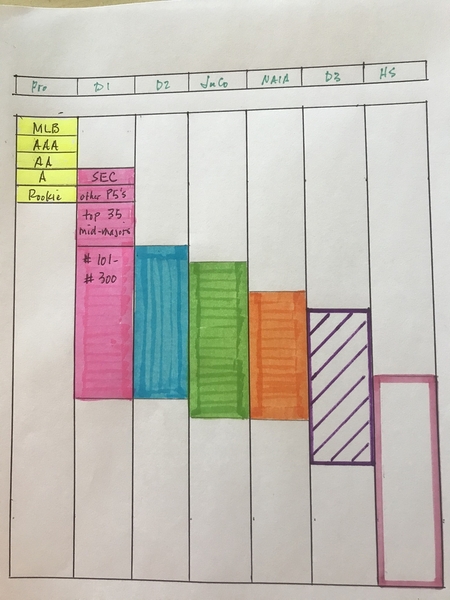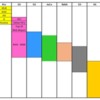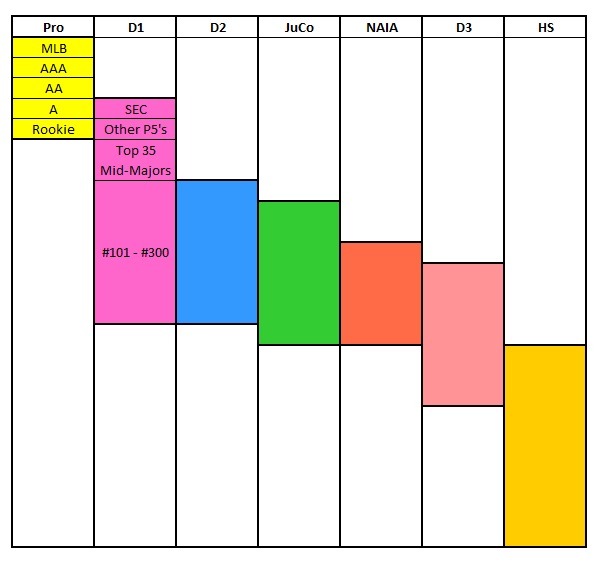When this thread started I began looking for a chart that I saw somewhere that compared levels of college play - which was the Q posed in the OP. I have looked everywhere and can’t find it - so I have recreated it to the best of my memory. Overall it’s a decent guideline. If it was my chart I might move a line or two - as most people would. 
IMHO there is a continuum with overlaps at every level which might mean the only difference between a D3, D2 player or D1 player are: who they know (whether or not we want to admit it, there are travel teams who have pipelines to certain schools and those schools may take a borderline player knowing that they can trust his work ethic...and that it will help them with the top tier player in a year or two); when they developed (sometimes a late bloomer explodes later in their playing career and sometimes a guy who was a stud at 15 maxes out and ends up overmatched in college); the other factors the family considered (do you want to be a big fish in a small pond, at a winning program, what's your major, etc.), academics etc... Continuing to play beyond HS is an enormous accomplishment no matter where you do it!
A couple of years ago, my husband asked a friend's son who played at a local mid-major the difference between levels, he said the main difference was the sheer number of guys that could: consistently barrel up 90+ pitching, get down the line under 4.5, throw consistently and accurately in the 90s with an exceptional secondary pitch, and/or make super athletic plays in the field look routine. He said at his school there are 3-4 guys who could do that. At the local P5, there are 6-8. At the top schools in the country, there's a whole slew of guys who can do at least one and most likely 2-3 of the above.
The last part of your question on differentiators between a stud D1 and a draft prospect... I think it's two things. One is projectability. How much is left in the tank. How much better do they think you can get. The other is the intangibles...twitch, competitive fire, leadership, work ethic, Bob's 6th's tool. I think all of those are in play going from HS to college but college coaches need to win right away. MLB teams have more of a luxury to dream on what someone can become.
He has rainbow colored hands right now.
When I was playing college summer ball forty-five years ago we were told the top teams in our league were the equivalent of AA ball. Almost everyone was D1 with a handful of good D3 players. Without knowing what I know now I scrambled the conversation by asking, “Then why does almost everyone drafted start at low A short season?”
RJM;
I agree. can you imagine playing in the Basin College Summer League 1956.
Our team, the Watertown Lake Sox employed 4 future MLB players [Perranoski, Howser, Bedell and Lindstrom] and the Basin League had 40 future MLB players, including Bob Gibson. Our Manager was Kermit Wahl, former MLB player.
The game that summer was at a "high" level requiring fast reflex reactions. For example Howie Bedell was 3.2 seconds home to 1st base. To survive the 6th Tool was necessary.
Bob
@Smitty28 posted:In baseball, everything is relative. One of the things I look at when watching a game is the speed of the game... how quick the top players are, how fast they react to hard ground balls, how fast they can turn a double play, how quick they are on back picks, even bunt plays. Top teams and top players play fast. Lesser players, regardless of how fast they can run or how hard they can throw or hit just can't keep up. Lots of guys can put up big numbers when standing still, but when you see top players move on the field they are different. When you've seen enough games you can tell a top team, a top player based on the way they play. This is why some guys with big numbers aren't getting attention, while other players with similar or lesser numbers are getting a lot of attention.
Exactly what I was curious about. Ty. It’s amazing what some of these instructors/scouts can pick up on. They can tell me what too look for and I still miss it!
@PitchingFan posted:I can tell you what the top teams look like. We played Vandy this week and it was incredible to watch. Their leadoff hitter is almost unstoppable to keep from stealing bases. The power between the two teams was incredible. 98 mph looked like 88 because it became so frequent. But it made 88 look like 78. The speed on both teams was crazy. We hit Leiter which is no easy feat. Actually had a true walk-on for us hit 3 Hr's on Saturday, with 2 being against Leiter, for the second time this season as he also did it in one game against LSU.
I think there are players at every level of baseball that can make it to MLB but I also realized this weekend that playing at the highest level in college makes it an easier job deciding for the scouts. If a guy can hit HR's against probably the most elite pitcher in college baseball and the flamethrowing closer for Vandy he can hit against anyone. But I think the lower level of college, especially for hitters but also for pitchers, takes a little more scouting knowledge. if you can hit or pitch successfully in the SEC or other top conferences you can hit or pitch in the pros. Hitting and pitching at the lower levels takes a lot more understanding of swing mechanics and pitchability for scouts. But there are guys who have done it.
Crazy! That is the game we were watching that me me ask that question! I was wondering what Evan’s (I believe that was him) future held. He’s a senior and smacked those three home runs!
Evan Russell is a guy who has earned respect this year in the SEC. He actually did not start this Friday night for a freshman. He came in halfway through game and made a great catch in LF. He hit 3 HR's in one game against LSU and hit another 3 HR's against Vandy on Saturday with 2 being against Leiter. He has caught a lot of attention this year because of his ability to hit HR's against the best pitching in SEC. He has made large jumps in the prospect lists for MLB draft and was listed on watch list on D1baseball this week. Only batting .226 but has 10 homeruns. Listed at 5'11" 195 pounds from Lexington, TN. True walk-on who believed in himself.
Interesting story on Saturday. There was a young man, 8 year old, I think having a birthday party in LF patio area. Him and his friends got all 3 of Russell's homeruns and 1 from Vandy. They cheered and talked to Russell the entire game. After the game, they were still in LF patio area cheering for Russell after the team meeting. He ran to the patio area and signed all three balls and posters for all the kids in the group. Baseball is about more than playing a game.
@adbono posted:When this thread started I began looking for a chart that I saw somewhere that compared levels of college play - which was the Q posed in the OP. I have looked everywhere and can’t find it - so I have recreated it to the best of my memory. Overall it’s a decent guideline. If it was my chart I might move a line or two - as most people would.
Nice. I think I have a spare MS Office license if you want it. Using Excel for this would save a lot of time and ink.
I just want to point out that this thread has been going on for a very long time and RJM has yet to ask me about carpeting Florida. Feels kinda weird.
D3 was not worthy of a purple fill in, only incomplete diagonal lines and in a particular direction and it was a distinct color from the rest of the bars...hmmm. HS had a just a border and was empty inside, an easy message to interpret given how my HS kid behaves.
Out of curiosity, are there no "bad" jucos? Isn't that also something that people would want to know? Adbono puts the worst of them slighly below the worst D1s - maybe that's pretty bad? Why are "bad" D3s so much worse than "bad" jucos?
The HS bar overlaps with all the college level bars
@anotherparent posted:Out of curiosity, are there no "bad" jucos? Isn't that also something that people would want to know? Adbono puts the worst of them slighly below the worst D1s - maybe that's pretty bad? Why are "bad" D3s so much worse than "bad" jucos?
There is bad baseball at all levels. It’s all relative.
@2022NYC posted:The HS bar overlaps with all the college level bars
Yes, I noticed that as well. I'd move the HS bar down quite a bit more. Remember 6% of HS players make it to the college level, and most college players have the benefit of year round workout, nutrition programs as well as practices. It would take an very elite HS to beat a college team, IMHO.
PS.....Great idea & graphic adbono
@fenwaysouth posted:Yes, I noticed that as well. I'd move the HS bar down quite a bit more. Remember 6% of HS players make it to the college level, and most college players have the benefit of year round workout, nutrition programs as well as practices. It would take an very elite HS to beat a college team, IMHO.
PS.....Great idea & graphic adbono
Fair point about the HS bar. It’s the hardest one to get right. The very best HS teams could beat a bad college team on any given day - and the very best HS players are selected in the MLB draft. The reverse is true as well. The really bad HS teams are so bad that they would lose to a good 14U travel ball team. The talent range in HS equals a bar as long as the Grand Canyon is wide.
Instead of rectangles for each division, you should use an upside-down pyramid. That might be a better representation of numbers that fall in these ranges in each division. I know that's somewhat impossible. You kind of do this in D1 by creating levels within your diagram. I think this is a great visual representation.
As I mentioned when I posted the graph, while I agree with most of it, it’s not my creation. I saw it somewhere: Twitter, Collegiate Baseball, Inside Pitch or somewhere else like that. When I couldn’t find it again I recreated it from memory. In doing so I probably made unintentional changes that aren’t very significant. There is a lot of stuff you could pick at if you are so inclined. For example, I don’t believe all D1 P5s are better than the top 35 D1 mid majors. In fact, I know they aren’t. There just isn’t any way to address every situation. In general I think it’s a pretty good broad brush comparison. I apologize for the suspect artwork but if I did it on Excel I would still be working on it.
@adbono posted:As I mentioned when I posted the graph, while I agree with most of it, it’s not my creation. I saw it somewhere: Twitter, Collegiate Baseball, Inside Pitch or somewhere else like that. When I couldn’t find it again I recreated it from memory. In doing so I probably made unintentional changes that aren’t very significant. There is a lot of stuff you could pick at if you are so inclined. For example, I don’t believe all D1 P5s are better than the top 35 D1 mid majors. In fact, I know they aren’t. There just isn’t any way to address every situation. In general I think it’s a pretty good broad brush comparison. I apologize for the suspect artwork but if I did it on Excel I would still be working on it.
I bet one of the kids in your company can make the graph for you in about 10 minutes.
@old_school posted:I bet one of the kids in your company can make the graph for you in about 10 minutes.
Working from home, so no tech support
Nope, I call anti-D3 bias, why is D3 gray when all the other levels get a beautiful color?!
@anotherparent posted:Nope, I call anti-D3 bias, why is D3 gray when all the other levels get a beautiful color?!
Gray is actually my favorite color!
@fenwaysouth posted:Yes, I noticed that as well. I'd move the HS bar down quite a bit more. Remember 6% of HS players make it to the college level, and most college players have the benefit of year round workout, nutrition programs as well as practices. It would take an very elite HS to beat a college team, IMHO.
PS.....Great idea & graphic adbono
Agreed, I just had a photo pop-up in my Google photos of my son being player of the week in the Marietta Daily Journal for Baseball. it was a result of him one hitting Lambert, who was the number one HS team in the country at the time. he struck out 11 in a complete game win and K’d the side three times, the last time being in the seventh and final inning. Their only hit was a blip behind short into shallow LF at the and he promptly picked the guy off at first, otherwise he would’ve thrown a no no.
IMHO, even the very best HS teams will have to play a flawless game vs any avg college team to beat them.
baseball is hard and there are so many levels for kids to play, improve and compete....I’d like to believe it’s popularity will rise and more kids will continue to play.
+1 to AdBono for the art project
You didn't put borders around JuCo. Does that mean the rating is more fluid?
@anotherparent posted:Nope, I call anti-D3 bias, why is D3 gray when all the other levels get a beautiful color?!
NAIA got no love either... it's baby poop brown
Very nice clean up on aisle 5 by Francis!
The graph make it look like only some HS are better than D3 and not NAIA or D1. IMG would differ.
I have some anecdotal observations that may be relevant in this thread related to the overlapping talent, specifically between D1 and D2. My son was a part of two college baseball programs - Mercer University, D1, Southern Conference and Georgia College D2, Peach Belt Conference. I'd say Mercer is a solid to very good mid major. They have several wins over ACC and SEC schools - beat Florida a couple years ago when UF was #1, Mercer had Kyle Lewis the Golden Spikes winner and AL Rookie of the Year, and probably average having 2 or 3 guys drafted a year. Georgia College is a good D2 baseball school that is pretty regularly nationally ranked, beat #1 Tampa U last year, and probably averages about 1 guy a year drafted.
Some generalizations based on being familiar with the programs for several years. Georgia College has had many position players that could have started or gotten regular playing time at Mercer. Some years as many as 3 or 4 GC position players were as good or better than Mercer starters. Most of the Mercer starting position players would start or play regularly at GC. In general the position players who do not start regularly at Mercer are measurably more talented than the position players who do not start at GC. In any given year GC would likely have three or four pitchers who could get significant innings at Mercer. It would be unlikely that any of them would be in the top 2 on the staff. Very close to all of the pitchers at Mercer would be able to contribute significantly if they were at GC and multiple guys would be considered an ace or top of the staff guys.





